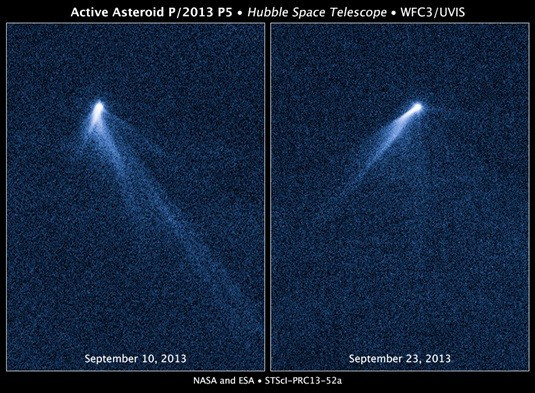UFO-like Object Spotted in Space Beyond Mars by Hubble Telescope

An unexplained sphere described by Nasa as "weird and freakish" with shooting jets of matter was spotted in the solar system.
It was later identified as a spinning rock located in the asteroid belt between Mars and Jupiter.
The asteroid, named P/2013 P5, was seen shooting matter from its surface by Hubble.
"We were literally dumbfounded when we saw it," said Professor David Jewitt, who leads the team exploring the "asteroid with six comet-like tails of dust radiating from it like spokes on a wheel."
The Hubble Space Telescope managed to capture an image of it, first in early September and then again 13 days later. At the later date, it looked completely different, as if it had done a 180-degree turn, said Nasa.
"Its tail structures change dramatically... as it belches out dust," said Professor David Jewitt, from the University of California.
"That also caught us by surprise. It's hard to believe we're looking at an asteroid."
Prof Jewitt went on to describe the unique appearance of the space rock.
"One idea was that we were seeing ice on the asteroid outgassing, but the object is too hot, around 170 Kelvin, for ice," he told The Register. "An impact with the asteroid was discussed but that would leave one large plume, not six."
Another theory is that the asteroid is breaking apart under the strain of its own rotation, causing it to spin around very quickly, apparently of its own volition.
The spin could be from the pressure build-up from many thousands of years of solar emissions.
Stars can emit protons and radiation and cause rotation of asteroids. Pressure from stars like the sun is constant and in space almost frictionless.
Therefore, asteroids spin faster and faster until they disintegrate. One theory is that this is a way that asteroids die.
"In astronomy, where you find one, you eventually find a whole bunch more," said Prof Jewitt, whose study of the rock was published in the Astrophysical Journal of Letters. "This is an amazing object and almost certainly the first of many more to come."
The giant rock is about 1,400 feet wide and probably reaches surface temperatures of 1,500 degrees Fahrenheit.
© Copyright IBTimes 2025. All rights reserved.






















